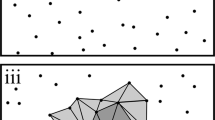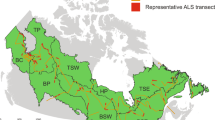Abstract
Old-growth forests consist of various types of small patches that reflect their own gap-forming process, which includes changes in environmental conditions occurring over several decades. We reconstructed the gap-forming processes that had occurred during a 40-year period for eight representative patches of an old-growth evergreen broad-leaved forest in Japan, and examined the current community structure. The selected patches were based on (1) changes in canopy heights estimated from aerial photographs taken in four different years, (2) long-term ecological research (LTER) monitoring records, and (3) a recent field survey, so that they sufficiently covered characteristic gap-forming processes such as a new gap, an old gap and consistently closed canopy. Height and diameter at breast height (DBH) were measured on all living trees taller than 1.3 m. In their height distributions, currently almost closed patches that were open in 1966 show a rotated sigmoid, whereas their DBH distributions are an inverse J-shape. In contrast, patches that have been consistently under a closed canopy exhibit gentle inverse J-shapes for both distributions. For species composition, there are no clear contrasts associated with the past gap-forming processes except for the existence of fast-growing deciduous species in large currently open patches. Our results suggested that the variation in several decades of gap-forming processes played a central role in the high patch diversity and the complex patch mosaic of the forest. Diverse gap-forming processes created micro-environmental heterogeneity both vertically and horizontally, and contributed to the maintenance of the species-rich, warm-temperate old-growth forest.





Similar content being viewed by others
References
Alvarez-Buylla ER (1994) Density dependence and patch dynamics in tropical rain forests: matrix models and applications to a tree species. Am Nat 143:155–191. doi:10.1086/285599
Aiba S, Kohyama T (1996) Tree species stratification in relation to allometry and demography in a warm-temperate rain forest. J Ecol 84:207–218. doi:10.2307/2261356
Alvarez-Buylla ER, García-Barrios R (1991) Seed and forest dynamics: a theoretical framework and an example from the neotropics. Am Nat 137:133–154. doi:10.1086/285150
Antos JA, Parish R (2002) Structure and dynamics of a nearly steady-state subalpine forest in south-central British Columbia, Canada. Oecologia 130:126–135
Bloor JMG, Grubb PJ (2003) Growth and mortality in high and low light: trends among 15 shade-tolerant tropical rain forest tree species. J Ecol 91:77–85. doi:10.1046/j.1365-2745.2003.00743.x
Blundell AG, Peart DR (2004) Density-dependent population dynamics of a dominant rain forest canopy tree. Ecology 85:704–715. doi:10.1890/01-4101
Brokaw NVL (1982) The definition of treefall gap and its effect on measures of forest dynamics. Biotropica 14:158–160. doi:10.2307/2387750
Denslow JS (1987) Tropical rainforest gaps and tree species diversity. Annu Rev Ecol Syst 18:431–451. doi:10.1146/annurev.es.18.110187.002243
Dubé P, Fortin MJ, Canham CD, Marceau DJ (2001) Quantifying gap dynamics at the patch mosaic level using a spatially explicit model of a northern hardwood forest ecosystem. Ecol Modell 142:39–60. doi:10.1016/S0304-3800(01)00238-1
Fujita T, Itaya A, Miura M, Manabe T, Yamamoto S (2003a) Canopy structure in a temperate old-growth evergreen forest analyzed by using aerial photographs. Plant Ecol 168:23–29. doi:10.1023/A:1024477227614
Fujita T, Itaya A, Miura M, Manabe T, Yamamoto S (2003b) Long-term canopy dynamics analyzed by aerial photographs in a temperate old-growth evergreen broad-leaved forest. J Ecol 91:686–693. doi:10.1046/j.1365-2745.2003.00796.x
Horvitz CC, Sternberg LDSLO (1999) 14C dating of tree falls on Barro Colorado Island (Panama): a new method to study tropical rain forest gap dynamics. J Trop Ecol 15:723–735. doi:10.1017/S0266467499001133
Hoshino D, Nishimura N, Yamamoto S (2003) Effects of canopy conditions on the regeneration of major tree species in an old-growth Chamaecyparis obtusa forest in central Japan. For Ecol Manage 175:141–152
Hubbell SP (2001) The unified neutral theory of biodiversity and biogeography. Princeton Univ. Press, Princeton
Hubbell SP, Foster RB, O’Brien ST, Harms KE, Condit R, Wechsler B, Wright SJ, Loo de Lao S (1999) Light-gap disturbances, recruitment limitation, and tree diversity in a neotropical forest. Science 283:554–557. doi:10.1126/science.283.5401.554
Ishiguro M, Sakamoto Y (1984) A Bayesian approach to the probability density estimation. Ann Inst Stat Math 36(B):523–538
Kohyama T, Suzuki E, Partomihardjo J, Yamada T, Kubo T (2003) Tree species differentiation in growth, recruitment and allometry in relation to maximum height in a Bornean mixed dipterocarp forest. J Ecol 91:797–806. doi:10.1046/j.1365-2745.2003.00810.x
Kwit C, Platt WJ (2003) Disturbance history influences regeneration of non-pioneer understory trees. Ecology 84:2575–2581. doi:10.1890/02-3130
Lertzman KP, Sutherland GD, Inselberg A, Saunders SC (1996) Canopy gaps and the landscape mosaic in a coastal temperate rain forest. Ecology 77:1254–1270. doi:10.2307/2265594
Lieberman M, Lieberman D, Peralta R (1989) Forests are not Swiss cheese: canopy stereogeometry of nongaps in tropical forests. Ecology 70:550–552. doi:10.2307/1940201
Lieberman M, Lieberman D, Peralta R, Hartshorn GS (1995) Canopy closure and the distribution of tropical forest tree species at La Selva, Costa Rica. J Trop Ecol 11:161–178
Manabe T, Yamamoto S (1997) Spatial distribution of Eurya japonica in an old-growth evergreen broad-leaved forest, SW Japan. J Veg Sci 8:761–772. doi:10.2307/3237020
Manabe T, Nishimura N, Miura M, Yamamoto S (2000) Population structure and spatial patterns for trees in a temperate old-growth evergreen broad-leaved forest in Japan. Plant Ecol 151:181–197. doi:10.1023/A:1026512404110
Miller DR, Quine CP, Hadley W (2000) An investigation of the potential of digital photogrammetry to provide measurements of forest characteristics and abiotic damage. For Ecol Manage 135:279–288
Miura M, Manabe T, Nishimura N, Yamamoto S (2001) Forest canopy and community dynamics in a temperate old-growth evergreen broad-leaved forest, south-western Japan: a 7-year study of a 4-ha plot. J Ecol 89:841–849. doi:10.1046/j.0022-0477.2001.00603.x
Montgomery RA, Chazdon RL (2002) Light gradient partitioning by tropical tree seedlings in the absence of canopy gaps. Oecologia 131:165–174. doi:10.1007/s00442-002-0872-1
Mori AS, Komiyama A (2008) Differential survival among life stages contributes to co-dominance of Abies mariesii and Abies veitchii in a sub-alpine old-growth forest. J Veg Sci 19:239–244
Nakashizuka T (2001) Species coexistence in temperate, mixed deciduous forests. Trends Ecol Evol 16:205–210. doi:10.1016/S0169-5347(01)02117-6
Nakashizuka T, Katsuki T, Tanaka H (1995) Forest canopy structure analyzed by using aerial photographs. Ecol Res 10:13–18. doi:10.1007/BF02347651
Nishimura N, Hara T, Miura M, Manabe T, Yamamoto S (2003) Tree competition and species coexistence in a warm-temperate old-growth evergreen broad-leaved forest in Japan. Plant Ecol 164:235–248. doi:10.1023/A:1021224429091
Ohwi J, Kitagawa M (1992) New flora of Japan, revised. Shibundo, Tokyo (in Japanese)
Parish R, Antos JA (2004) Structure and dynamics of an ancient montane forest in coastal British Columbia. Oecologia 141:562–576. doi:10.1007/s00442-004-1690-4
Poorter L, Bongers F, Sterck FJ, Wöll H (2005) Beyond the regenerating phase: differentiation of height-light trajectories among tropical tree species. J Ecol 93:256–267. doi:10.1111/j.1365-2745.2004.00956.x
Runkle JR (1982) Patterns of disturbance in some old-growth mesic forests of eastern North America. Ecology 63:1533–1546. doi:10.2307/1938878
Sakamoto Y (1991) Categorical data analysis by AIC. Kluwer, Dordrecht
Sanford RL Jr, Braker HE, Hartshorn GS (1986) Canopy openings in a primary neotropical lowland forest. J Trop Ecol 2:277–282
Sato T, Tanouchi H, Takeshita K (1994) Initial regenerative processes of Distylium racemosum and Persea thunbergii in an evergreen broad-leaved forest. J Plant Res 107:331–337. doi:10.1007/BF02344261
Shimatani K, Kubota Y, Araki K, Aikawa S, Manabe T (2007a) Matrix models using very fine size classes and their applications to population dynamics of tree species: Bayesian nonparametric estimation. Plant Species Biol 22:175–190. doi:10.1111/j.1442-1984.2007.00190.x
Shimatani K, Kawarasaki S, Manabe T (2007b) Describing size-related mortality and size distribution by nonparametric estimation and model selection using Akaike Bayesian Information Criterion. Ecol Res 23(2):289–297
Tanouchi H, Sato T, Takeshita K (1994) Comparative studies on acorn and seedling dynamics of four Quercus species in an evergreen broad-leaved forest. J Plant Res 107:153–159. doi:10.1007/BF02346011
Takyu M, Ohsawa M (1997) Distribution and regeneration strategies of major canopy dominants in species-rich subtropical/warm temperate rainforests in south-western Japan. Ecol Res 12:139–151. doi:10.1007/BF02523779
Watt AS (1947) Pattern and process in the plant community. J Ecol 35:1–22. doi:10.2307/2256497
Wehrli A, Zingg A, Bugmann H, Huth A (2005) Using a forest patch model to predict the dynamics of stand structure in Swiss mountain forests. For Ecol Manage 205:149–167
Whitmore TC (1989) Canopy gaps and the two major groups of forest trees. Ecology 70:536–538. doi:10.2307/1940195
Yamamoto S (1992) Gap characteristics and gap regeneration in primary evergreen broad-leaved forests of western Japan. Bot Mag Tokyo 105:29–45. doi:10.1007/BF02489401
Zang R, Tao J, Li C (2005) Within community patch dynamics in a tropical montane rain forest of Hainan Island, south China. Acta Oecol 28:39–48. doi:10.1016/j.actao.2005.02.001
Acknowledgments
We thank Dr. A. Itaya for helping us draw the canopy maps. Staff from the Nagasaki Forest Office and the Hotel Tachibana gave their kind support. We are grateful to H. Itoh and H. Yamakawa for their help in the field survey. This study was supported by a Grant-in-Aid for Science Research (No. 14206017 and 16380111) from the Ministry of Education, Science, Sports and Culture, Japan, and by the ISM Cooperative Research Program (2004-ISM-CRP-2048 and 2005-ISM-CRP-2041) and ISM Project Research 2004. Dr. Y. Iwasa and three anonymous reviewers made valuable suggestions and helpful comments to improve an earlier draft of the manuscript.
Author information
Authors and Affiliations
Corresponding author
Appendix
Appendix
About this article
Cite this article
Manabe, T., Shimatani, K., Kawarasaki, S. et al. The patch mosaic of an old-growth warm-temperate forest: patch-level descriptions of 40-year gap-forming processes and community structures. Ecol Res 24, 575–586 (2009). https://doi.org/10.1007/s11284-008-0528-7
Received:
Accepted:
Published:
Issue Date:
DOI: https://doi.org/10.1007/s11284-008-0528-7




